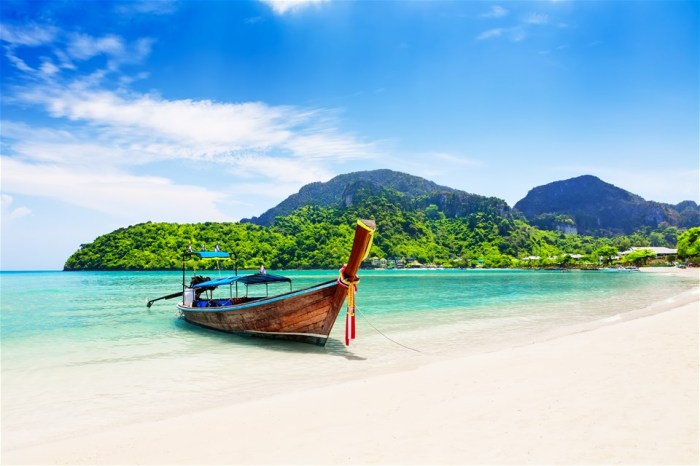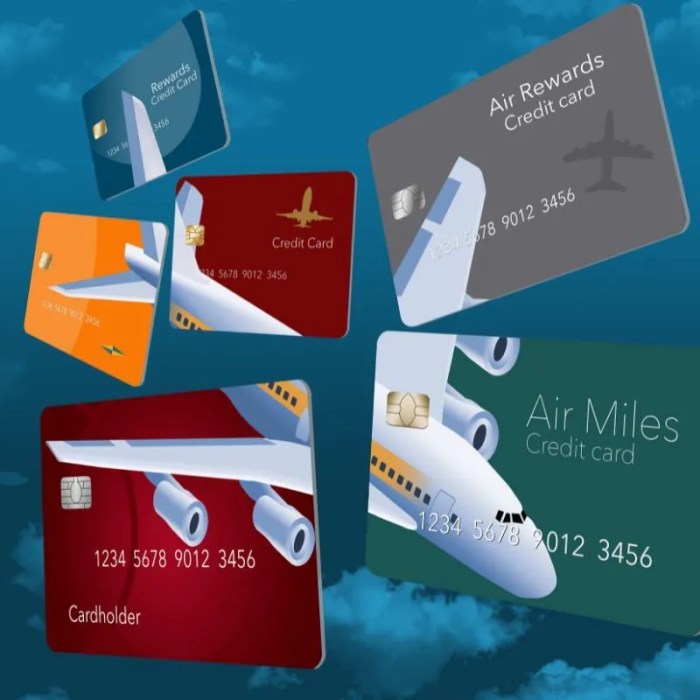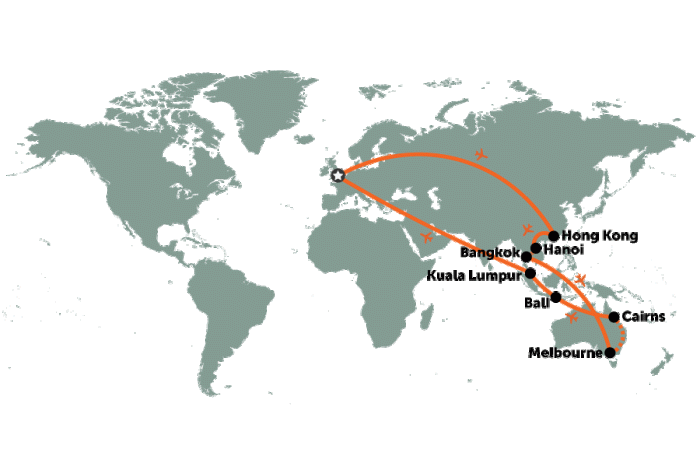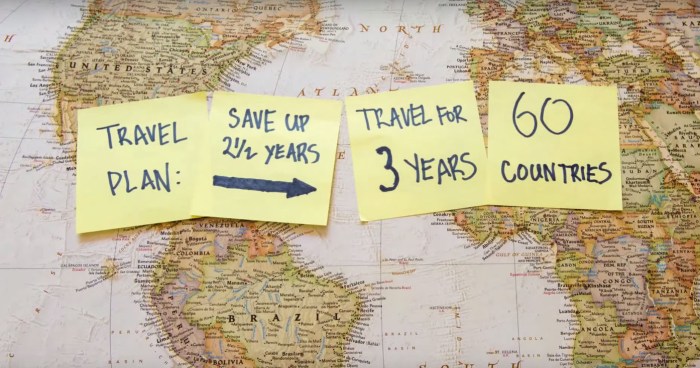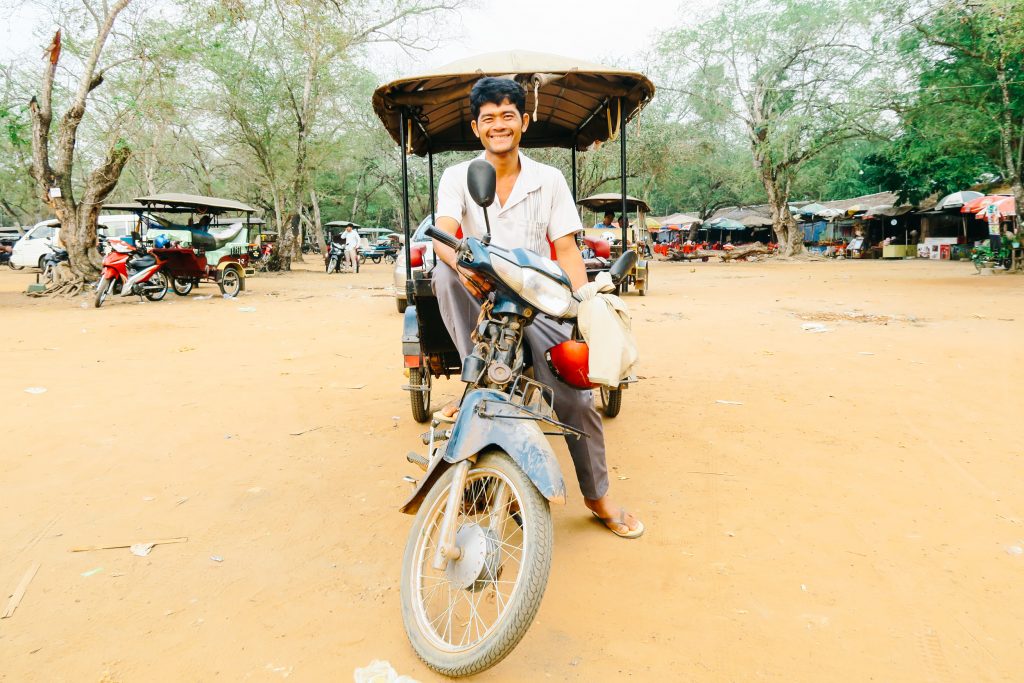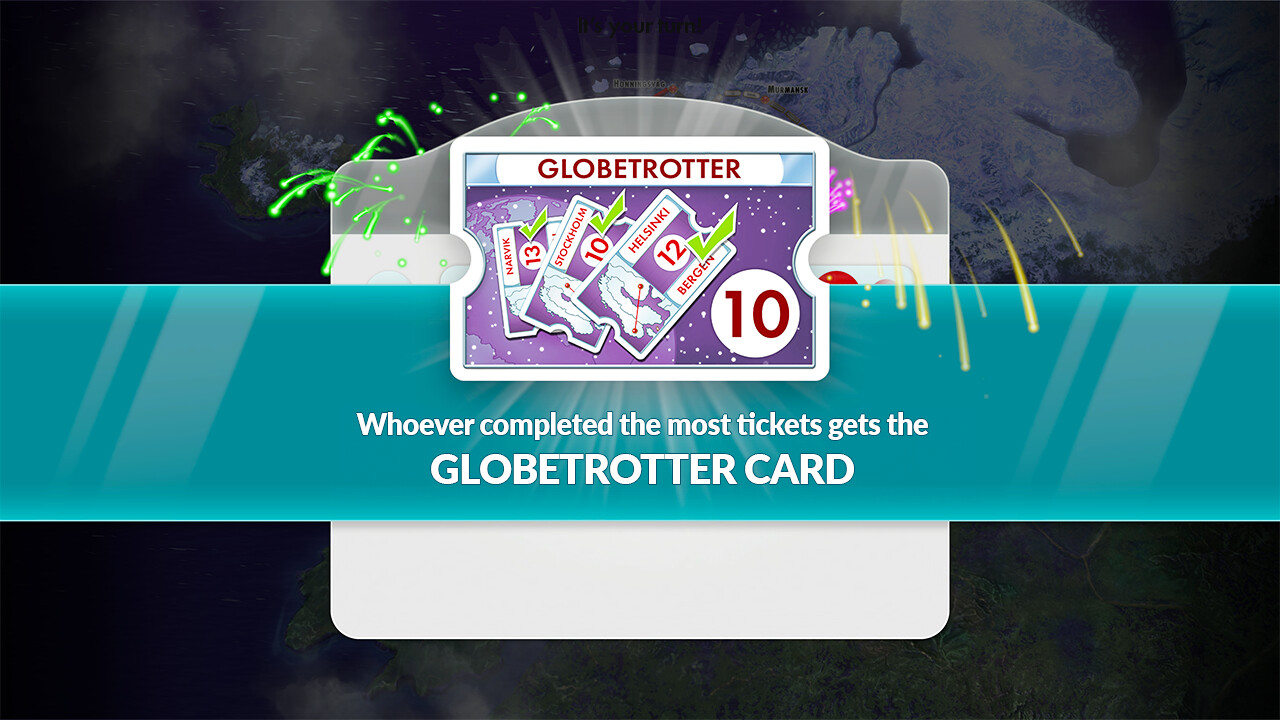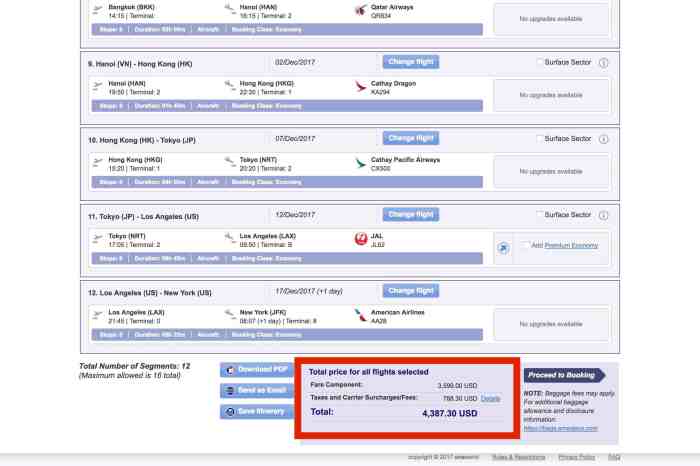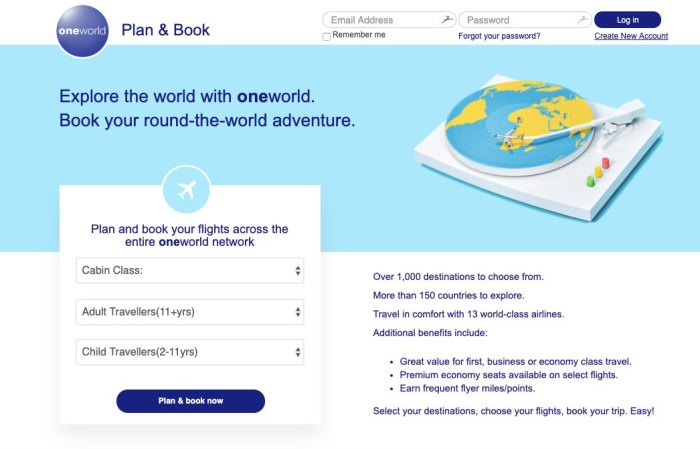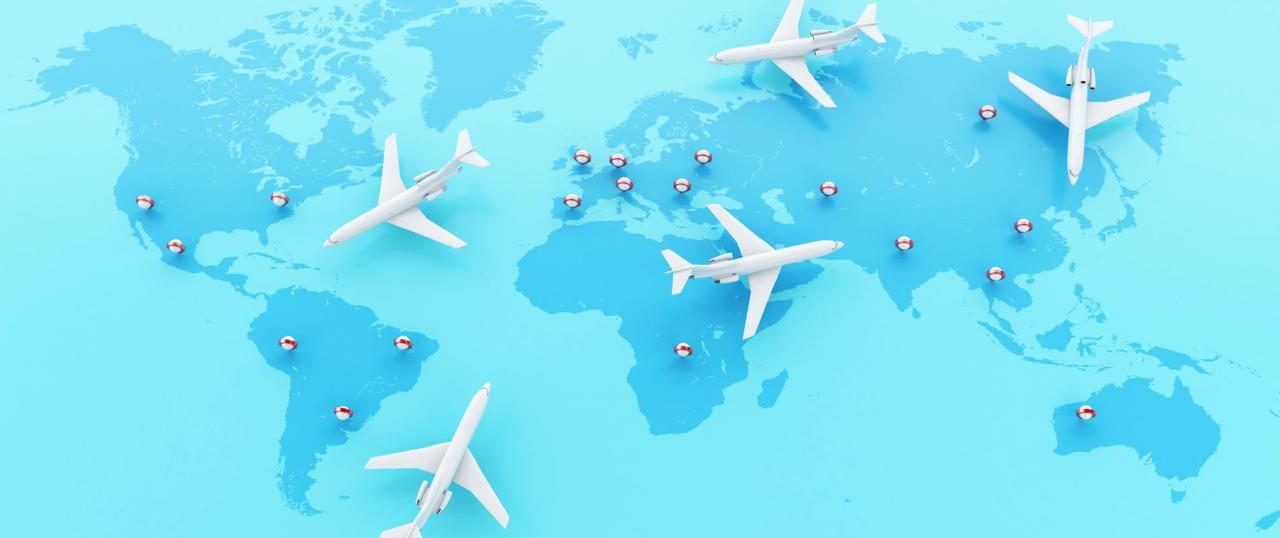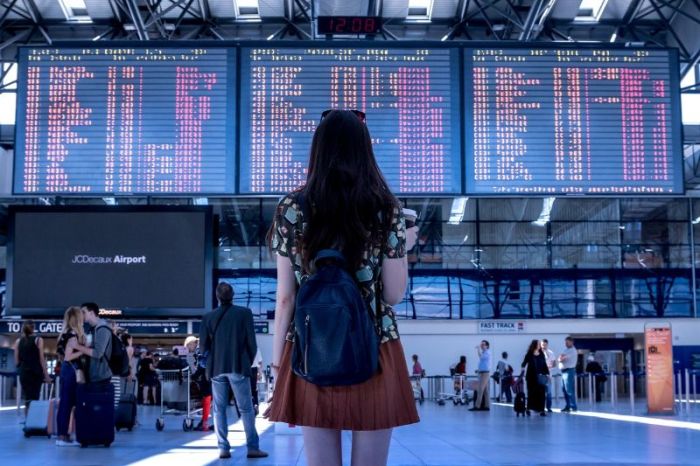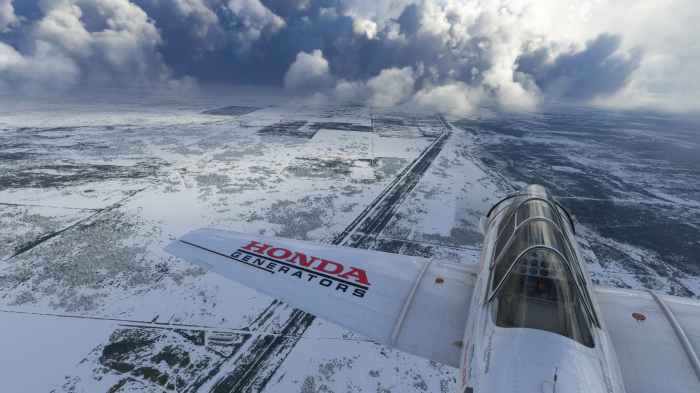3 Month Round the World Trip: embarking on a global adventure in just three months is a thrilling prospect, but meticulous planning is key to a seamless and unforgettable journey. This guide provides a comprehensive overview of everything you need to know, from crucial trip planning considerations and transportation strategies to accommodation choices, activities, packing essentials, health and safety precautions, and frequently asked questions.
Imagine exploring vibrant cities, lush landscapes, and ancient cultures across continents. This comprehensive guide will equip you with the knowledge and strategies to plan your dream 3-month round-the-world adventure, from initial budgeting to final packing lists.
Trip Planning Considerations
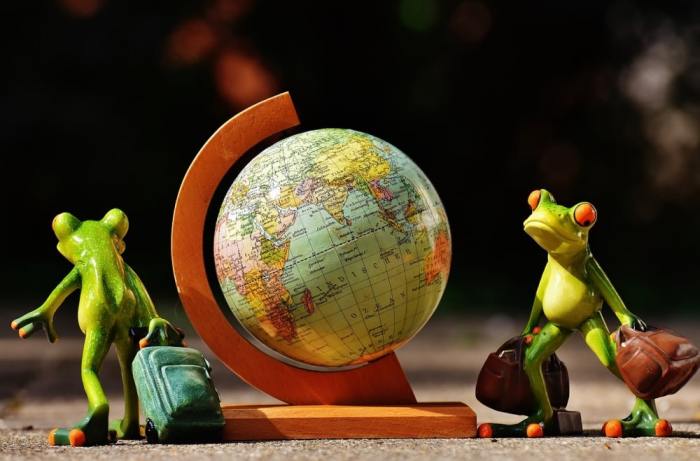
Source: revolvingcompass.com
A three-month round-the-world journey demands meticulous planning. This involves more than simply booking flights; it necessitates a comprehensive approach to budgeting, visa requirements, and potential challenges. A well-structured itinerary, coupled with a realistic budget, will greatly enhance the travel experience.
Essential Steps in Trip Planning
Thorough preparation is crucial for a smooth and enjoyable round-the-world adventure. This entails researching destinations, identifying preferred activities, and creating a flexible itinerary. Understanding visa requirements, currency exchange rates, and local customs is also vital. This initial groundwork sets the stage for a seamless and enriching experience.
Planning a three-month round-the-world trip requires careful consideration, especially when it comes to securing the right airfare. Finding the most cost-effective and efficient round world trip flights is crucial for maximizing your travel time and minimizing expenses. This often involves complex routing and booking strategies to make the most of your 3-month adventure.
Budgeting Strategies for a Round-the-World Trip
Developing a comprehensive budget is essential for managing expenses during a three-month journey. Travelers should factor in costs for flights, accommodation, food, activities, and local transportation. Different regions have varying cost structures, impacting overall expenditure. For instance, Southeast Asia generally offers more affordable options compared to Western Europe.
- Accommodation: Consider a mix of hostels, guesthouses, and budget hotels for cost-effectiveness. Alternatively, explore homestays for a more immersive cultural experience. For example, hostels can cost as little as $10-$20 per night, while budget hotels can range from $30-$50.
- Food: Eating local street food can be a budget-friendly way to experience diverse cuisines. In contrast, dining in upscale restaurants or tourist traps can quickly deplete funds. Exploring local markets for fresh produce and groceries can also contribute to cost savings.
- Activities: Free activities like hiking, exploring parks, or visiting local markets are excellent ways to save money. In addition, take advantage of free walking tours or cultural events.
Potential Challenges and Solutions
A round-the-world trip is filled with exciting adventures but also potential obstacles. Unexpected events, lost luggage, or sudden illnesses can disrupt the itinerary. A contingency plan with backup options is crucial for addressing unforeseen circumstances.
- Currency Exchange: Exchange currency in advance to avoid exorbitant fees at airports. Use online converters to understand the current exchange rates and avoid paying excessive fees.
- Health Concerns: Ensure necessary vaccinations and travel insurance. Pack a basic first-aid kit and know local healthcare facilities. Always be aware of the local health guidelines.
- Language Barriers: Learn basic phrases in the local language to facilitate communication. Download translation apps for quick assistance.
Visa Requirements for Popular Destinations
Visa requirements vary considerably between countries. It is essential to check the specific requirements for each destination. A pre-trip checklist is invaluable for ensuring smooth travel.
| Country | Visa Type | Required Documents | Processing Time |
|---|---|---|---|
| Thailand | Tourist Visa | Passport, Visa application form, Proof of funds, Round-trip tickets | 3-5 business days |
| Japan | Tourist Visa | Passport, Visa application form, Proof of funds, Itinerary, Letter of invitation | 7-10 business days |
| Australia | Tourist Visa | Passport, Visa application form, Proof of funds, Travel itinerary | 5-7 business days |
Sample Itinerary: Southeast Asia
This sample itinerary focuses on Southeast Asia, highlighting a mix of cultural immersion and relaxation. It offers a flexible framework that can be customized to individual preferences. Travelers should be prepared for varying weather conditions across the region.
- Week 1: Thailand (Bangkok, Chiang Mai): Explore temples, markets, and experience the vibrant city life.
- Week 2: Vietnam (Hanoi, Ho Chi Minh City): Discover historical sites, indulge in street food, and experience the rich culture.
- Week 3: Cambodia (Siem Reap): Explore the magnificent Angkor Wat temple complex and discover the nation’s history.
- Week 4: Laos (Luang Prabang): Enjoy the serene atmosphere, explore ancient temples, and experience the tranquil beauty of the country.
Transportation Strategies
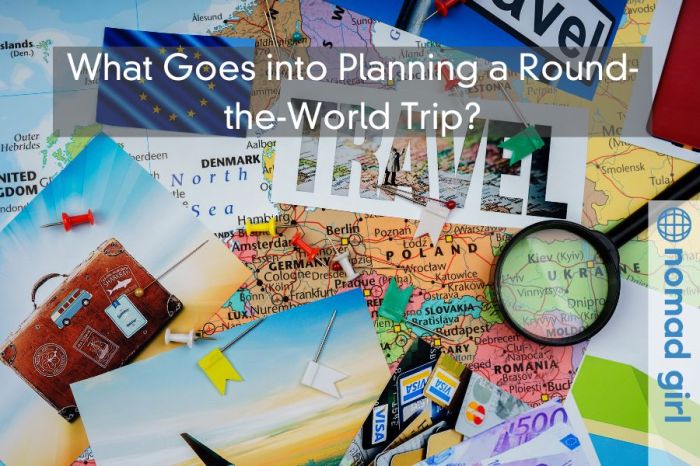
Source: nomadgirl.co
Global travel necessitates careful consideration of various transportation methods. Choosing the optimal mode depends on factors like budget, desired speed, and the specific destinations. A well-structured transportation plan is crucial for a smooth and efficient round-the-world journey.Effective transportation planning allows for a flexible itinerary and efficient use of time. This involves comparing the merits of various options, understanding their costs, and allocating time effectively to maximize experiences at each destination.
The goal is to balance the desire for a fast trip with the need to fully enjoy each location.
Comparative Analysis of Transportation Methods
Different modes of transport offer varying levels of comfort, speed, and cost. Careful evaluation of these aspects is essential for selecting the most suitable method for each leg of the journey. Flights offer speed but often come at a higher cost. Trains provide a more scenic experience and can be budget-friendly on longer routes. Buses and ferries offer more affordable options, but typically involve more travel time.
- Flights: Flights are ideal for covering long distances quickly. They offer convenience and speed, but often carry a higher price tag compared to other options. Factors like booking time, destination, and airline can influence the cost significantly.
- Trains: Trains are suitable for longer journeys and offer a unique travel experience, often passing through diverse landscapes. They can be a cost-effective alternative to flights, especially for longer routes, but travel times are typically longer.
- Buses: Buses are a budget-friendly option for shorter to medium-length distances. They are accessible and can offer a chance to connect with local cultures. However, travel times are significantly longer than flights or trains.
- Ferries: Ferries are a viable option for crossing bodies of water, often providing unique perspectives on coastal regions. They can be more economical than flying for certain routes but are generally slower than other options.
Choosing the Right Transportation for Different Segments
The choice of transportation should be tailored to the specific leg of the journey. Consider factors such as distance, time constraints, budget, and desired travel experience. For example, a high-speed train might be ideal for a short trip between European cities, while a flight might be necessary for a long-haul journey to Asia. Ferry travel might be perfect for a scenic island hopping experience.
Sample Timetable for a 3-Month Trip
A well-organized timetable ensures efficient travel and maximizes the trip’s enjoyment. It balances the desire to see many locations with the need to allow time for exploration.
A three-month round-the-world trip presents a unique opportunity to immerse oneself in diverse cultures and landscapes. Planning such a journey demands careful consideration of logistics, and resources like Travel guides can prove invaluable. Ultimately, the rewards of experiencing global destinations firsthand are substantial for those embarking on this incredible adventure.
- Week 1: Flights from origin to Southeast Asia, exploring several countries. Accommodation is booked for this period.
- Week 2-4: Train travel throughout Southeast Asia to visit various locations. Accommodation and activities are planned.
- Week 5-7: Flights to South America, using local transport within each country. Accommodation and activities are pre-booked.
- Week 8-9: Train travel through South America. Accommodation and planned activities for the region are organized.
- Week 10-12: Flights back to the origin. Pre-booked flights and hotels.
Cost Comparison: Flights vs. Trains
A table below compares the costs of flights and train travel between specific cities. This data is based on average costs and can vary depending on the time of year and booking date.
| Route | Flight Cost | Train Cost | Time Difference |
|---|---|---|---|
| London to Paris | $200 | $100 | 2 hours |
| New York to Los Angeles | $500 | $300 | 2 days |
| Tokyo to Kyoto | $350 | $150 | 2 hours |
Accommodation Options
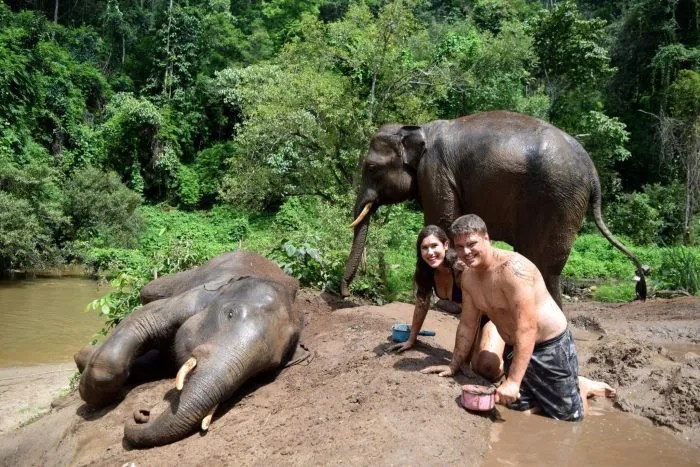
Source: ourescapeclause.com
Global travel necessitates careful consideration of accommodation, from the budget-conscious traveler to the luxury seeker. Selecting the right lodging significantly impacts the overall trip experience, influencing both the cost and the quality of your adventures. Finding suitable options across diverse destinations requires strategic planning and a flexible approach.Accommodation options span a wide spectrum, from budget-friendly hostels to lavish hotels.
The choice often hinges on personal preferences, budget constraints, and desired level of comfort. Each type of lodging offers distinct advantages and disadvantages, which need to be weighed carefully. Factors such as location, amenities, and safety should be assessed to optimize the travel experience.
Budget-Friendly Accommodation
Budget-friendly accommodation options are essential for maximizing your travel experience without straining your finances. Hostels, guesthouses, and budget hotels are excellent choices for travelers seeking cost-effective stays. These options often provide shared spaces, fostering a sense of community among fellow travelers. However, shared bathrooms and limited privacy can be drawbacks. Understanding these trade-offs is critical for making informed decisions.
Mid-Range Accommodation
Mid-range accommodations strike a balance between budget-conscious options and luxury choices. This category includes hotels, bed and breakfasts, and vacation rentals. These accommodations frequently offer more space, better amenities, and a higher level of comfort than budget options. The trade-off often involves a higher cost. Strategic booking and research are essential for finding suitable mid-range accommodations at competitive rates.
Luxury Accommodation
Luxury accommodations cater to travelers seeking the utmost comfort and exclusivity. High-end hotels, resorts, and villas provide exceptional amenities, personalized service, and unparalleled experiences. However, these accommodations often come with a substantial price tag. Luxury accommodations are best suited for travelers seeking a lavish and unforgettable experience. Careful consideration of costs and the desired level of luxury is essential for making an informed choice.
Booking Accommodation in Advance
Advance booking is crucial for securing suitable accommodations, especially during peak seasons. A well-planned approach allows you to compare various options, choose the best fit, and secure your stay in advance. Using online travel agencies (OTAs) and booking websites can help you locate and compare available accommodations across different regions and price points. This pre-emptive booking ensures that you have the desired accommodation during your trip.
A three-month round-the-world trip offers incredible experiences, but planning can be overwhelming. Exploring local trails, like those detailed in trails around me , can provide a vital taste of the destinations before committing to the full global adventure. This localized exploration helps fine-tune your itinerary for a truly enriching and memorable three-month round-the-world journey.
Strategies for Finding Budget-Friendly Accommodation
Finding budget-friendly accommodations requires a proactive approach and a willingness to consider alternative options. Exploring local guesthouses, homestays, and hostels can significantly reduce costs. Utilizing online travel agencies, comparing prices across multiple platforms, and looking for last-minute deals are effective strategies. These options can provide a valuable opportunity to experience local culture and customs.
Southeast Asia Accommodation Examples
| Accommodation Type | Cost (USD/night) | Location | Amenities |
|---|---|---|---|
| Hostel (Bangkok) | 15-30 | Central Bangkok | Dorms, shared bathrooms, common areas |
| Boutique Hotel (Hoi An) | 50-100 | Historic Hoi An | Breakfast, Wi-Fi, pool |
| Luxury Resort (Bali) | 200+ | Beachfront, Ubud | Private villas, infinity pools, spas |
This table showcases a range of accommodation options in Southeast Asia, highlighting the diversity of choices available across different price ranges and locations. This diversity offers travelers numerous options to fit various budgets and preferences.
Activities and Experiences
Global travel, especially a three-month round-the-world journey, offers a unique opportunity to immerse oneself in diverse cultures and landscapes. Careful planning is crucial to maximize experiences and ensure a fulfilling trip. This section details strategies for crafting impactful activities, emphasizing cultural immersion and adventure travel.Planning activities requires meticulous research and consideration of individual interests. Prioritizing experiences that connect with local communities and customs enhances the authenticity of the trip.
The approach should be adaptive, allowing for spontaneity and unexpected encounters.
Planning a three-month round-the-world trip? Before you jet off, consider exploring nearby hiking trails. Finding fantastic local hikes can be a rewarding experience, and a great way to test your fitness before your big adventure. Check out places for hiking near me for some inspiration. These adventures can build your confidence and physical preparedness for your global expedition.
Cultural Immersion Strategies
Planning for activities that maximize cultural experiences requires understanding the nuances of each region. Researching local customs, traditions, and etiquette before arrival is essential. Booking guided tours led by local experts provides invaluable insights into history, culture, and daily life. Participatory experiences, such as cooking classes or craft workshops, offer a deeper understanding of local traditions. Visiting local markets and interacting with vendors offers firsthand glimpses into daily life and the economy.
Unique Experiences
Beyond the typical tourist attractions, seeking unique experiences enhances the trip’s impact. Volunteering in local communities, learning a few phrases in the local language, or attending local festivals adds depth and authenticity. Exploring off-the-beaten-path destinations, whether small villages or remote natural areas, can reveal hidden gems and foster a profound connection with the region. Consider attending a traditional ceremony, participating in a local sport, or exploring a lesser-known historical site.
Southeast Asia Activities
This region offers a vibrant tapestry of cultures and landscapes. Here are some potential activities:
| Activity | Location | Duration | Cost |
|---|---|---|---|
| Attend a traditional dance performance | Various locations (e.g., Bali, Thailand) | 2-3 hours | $10-$50 |
| Learn to cook local cuisine | Various locations (e.g., Thailand, Vietnam) | 1-2 days | $20-$100 |
| Visit a local market | Various locations (e.g., Bangkok, Hanoi) | Half-day | Variable |
| Explore a national park | Various locations (e.g., Angkor Wat, Ha Long Bay) | 1-3 days | $30-$200+ |
Popular Activities by Region
The following table provides a snapshot of popular activities in each region, offering a range of options for diverse interests.
| Region | Activity | Description | Cost |
|---|---|---|---|
| Southeast Asia | Island Hopping | Exploring the islands of Southeast Asia, typically including snorkeling, swimming, and relaxing on beaches. | $50-$500+ |
| South America | Trekking in the Andes | Challenging but rewarding hikes in the majestic Andes Mountains. | $100-$1000+ |
| Europe | Wine Tasting Tour | Sampling local wines in vineyards and wine cellars. | $50-$200+ |
| East Asia | Temple Visits | Visiting historical temples and shrines to learn about the region’s rich history and culture. | Variable |
Packing and Essentials
A successful round-the-world trip hinges on meticulous planning, and packing is a crucial component. Careful consideration of clothing, electronics, and personal items, along with adaptable strategies for diverse climates, ensures a smooth and enjoyable journey. Properly prepared travel documents and safety precautions further contribute to a secure and worry-free experience.Effective packing minimizes stress and maximizes enjoyment during the trip.
Adaptable clothing options and a thoughtful approach to personal items contribute to a streamlined and comfortable experience. Packing light while maintaining all the necessities for various climates and activities requires careful planning. This is a key aspect of a successful round-the-world journey.
Clothing Essentials
A well-curated wardrobe is essential for a comfortable and efficient journey. The clothing choices must account for a wide range of weather conditions and activities, from bustling city streets to remote mountain trails. Packing versatile, quick-drying items in neutral colors is a smart strategy. Layering clothing allows for adapting to temperature changes effectively.
- Base layers (thermal underwear): These are vital for temperature regulation in diverse climates. Choose moisture-wicking materials to maintain comfort during various activities.
- Mid-layers (sweaters, jackets): A range of mid-layers is necessary for unpredictable weather fluctuations, providing extra warmth or insulation as needed.
- Outer layers (waterproof jacket, windbreaker): Essential for protection from rain, wind, and extreme temperatures. A versatile outer layer is crucial for unforeseen weather conditions.
- Versatile bottoms (pants, shorts, skirts): Choose options that are comfortable and appropriate for various activities and climates. Consider quick-drying materials for humid or active days.
- Comfortable walking shoes: Durable and comfortable shoes are essential for navigating diverse terrains and city streets.
- Swimsuits (if applicable): Packing swimsuits is essential for any destinations offering water activities or warm climates.
- Formal wear (if needed): A versatile formal outfit can be beneficial for special events or cultural interactions.
Electronics and Personal Items, 3 month round the world trip
Essential electronics and personal items must be carefully considered to ensure comfort and safety. These items provide vital communication, entertainment, and personal care necessities.
- Portable charger: A must-have for keeping electronic devices powered throughout the journey.
- International adapter: Ensures compatibility with electrical outlets in different countries.
- Camera and accessories: Documenting the journey through photographs or videos.
- Books or e-reader: Entertainment options for travel time or downtime.
- Medications: Pack necessary prescriptions and over-the-counter medications, along with any personal health requirements.
- First-aid kit: A basic first-aid kit is crucial for minor injuries or ailments.
- Sunscreen, insect repellent: Protect yourself from the sun and insects, which are prevalent in various destinations.
Travel Documents and Safety Precautions
Travel documents and safety precautions are essential for a secure and worry-free trip. These documents and precautions ensure smooth travel and personal safety.
- Passport and visa: Ensure your passport is valid for at least six months beyond your intended stay in each country.
- Copies of important documents: Make copies of your passport, visa, and other important documents and keep them separate from the originals.
- Travel insurance: Protect yourself against unforeseen circumstances, such as medical emergencies or lost belongings.
- Emergency contact information: Share your itinerary and emergency contact information with someone back home.
- Local emergency numbers: Have local emergency numbers for each country you will visit.
- Learn basic phrases in local languages: Knowing basic phrases in the local language can facilitate communication and interactions.
Packing Checklist for Different Climates
A packing checklist is essential for managing different climates. It helps to ensure you are prepared for any weather condition.
| Climate | Clothing Items | Other Essentials |
|---|---|---|
| Hot and Humid | Lightweight clothing, breathable fabrics, swimwear, sunscreen, insect repellent | Portable fan, water bottles, reusable bags |
| Cold and Snowy | Warm layers, waterproof jacket, gloves, hat, scarf, thermal underwear | Insulated water bottles, hand warmers |
| Desert | Light, loose-fitting clothing, wide-brimmed hat, sunglasses, sunscreen | Water bottles, reusable water bottles, sunscreen |
| Rainy | Waterproof jacket, rain pants, umbrella, waterproof bags | Extra socks, rain boots |
Health and Safety Considerations: 3 Month Round The World Trip
A global adventure demands meticulous planning beyond the itinerary. Prioritizing health and safety ensures a positive and productive journey. Careful consideration of potential health risks, necessary precautions, and robust safety measures is crucial for a smooth and secure trip.Navigating diverse environments, from bustling urban centers to remote wilderness areas, requires proactive strategies to mitigate potential health issues and ensure personal security.
This section Artikels essential health precautions, safety measures, and practical advice for maintaining well-being throughout your 3-month journey.
Essential Vaccinations and Medications
Pre-trip vaccinations are critical for protecting against infectious diseases prevalent in various regions. Consult a travel clinic or your physician for personalized recommendations based on your itinerary and health history. This consultation should include discussions on required vaccinations, necessary medications, and any potential health concerns related to your destination. The specific vaccinations needed will depend on the countries you plan to visit, and some destinations might require specific vaccinations or health certificates.
For example, Yellow Fever vaccinations may be mandatory for certain African countries. Be sure to schedule appointments well in advance, as some vaccinations require multiple doses and time for the body to build immunity.
Travel Insurance
Comprehensive travel insurance is non-negotiable. It should cover medical emergencies, trip cancellations, lost belongings, and personal liability. Research and compare various policies from reputable providers, considering factors like coverage amounts, waiting periods, and exclusions. Evaluate the cost-benefit of different insurance plans and choose a policy that meets your specific needs. Always have a copy of your policy and relevant medical records readily available.
Health Management During the Trip
Maintaining good hygiene is essential, particularly in areas with potential health risks. Staying hydrated, eating safe food, and avoiding risky activities can prevent many common ailments. A basic first-aid kit, including pain relievers, anti-diarrheal medication, and any personal medications, should be packed. Additionally, it’s wise to research local pharmacies and medical facilities in the areas you’ll be visiting.
Safety Measures in Different Regions
Understanding local customs, laws, and potential safety concerns in each region is crucial. Be mindful of your surroundings, avoid displaying expensive items, and be aware of potential scams. Consider taking a self-defense course or learning basic phrases in the local language. Research the local emergency services numbers and contact information before you travel. If possible, share your itinerary with trusted contacts back home, and consider using a personal safety app or device.
Resources for Vaccination and Insurance Information
Reliable resources for vaccination information include your physician, local travel clinics, and the Centers for Disease Control and Prevention (CDC) website. For travel insurance, reputable comparison websites and travel insurance providers offer detailed information about coverage options. Always verify the authenticity of the information obtained from any online resource.
Staying Safe While Traveling
Be vigilant about personal safety, particularly in unfamiliar areas. Avoid walking alone at night, be cautious of your belongings, and trust your instincts. Inform your accommodation of your itinerary, and leave a copy of your passport and travel documents in a secure location. Report any suspicious activity to local authorities immediately. Remember to be respectful of local customs and laws, and always prioritize your safety.
Epilogue
Successfully navigating a 3-month round-the-world trip requires meticulous planning, adaptability, and a willingness to embrace the unexpected. This guide has provided a framework for you to create a personalized journey that balances your desires with realistic expectations. Remember, the most important aspect is to enjoy the experience, make memories, and embrace the unique opportunities that await you on this incredible adventure.
General Inquiries
What’s the best way to budget for a 3-month round-the-world trip?
Creating a detailed budget that accounts for different regions’ costs is essential. Consider your spending habits, anticipate potential expenses, and look for opportunities to save, such as utilizing budget airlines and local transportation. Flexibility in your itinerary is crucial as unexpected costs can arise.
What are some common visa challenges for a 3-month round-the-world trip?
Visa requirements vary significantly by country. Thorough research and early application are crucial. The guide includes a sample table with visa requirements for popular destinations, highlighting the necessary documents and processing times. Consulting an immigration lawyer specializing in international travel can provide further assistance.
How can I stay healthy during a 3-month round-the-world trip?
Maintaining your health is paramount. Consult your doctor about necessary vaccinations and medications well in advance. Pack essential medications and consider travel insurance that covers medical emergencies. Staying hydrated and eating fresh food whenever possible can help prevent illness.
How can I manage potential issues during the trip?
Anticipate potential problems, from lost luggage to unexpected delays. Building flexibility into your itinerary, and having a backup plan, can significantly mitigate issues. Sharing your itinerary with a trusted contact back home can provide peace of mind and emergency support.



